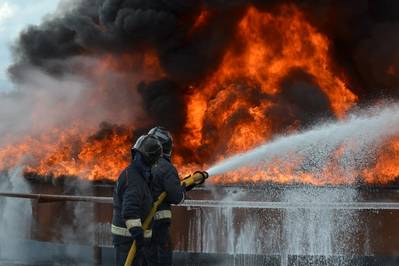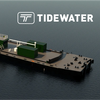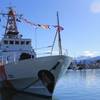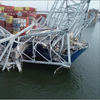Marine Industry Faces 2026 Deadline for Fluorine-free Foam
Aqueous film-forming foam (AFFF) has been used to extinguish fires aboard maritime vessels since its introduction in the 1960s. For decades, AFFF was the foam of choice due to its effectiveness and affordability. However, over the last 15 years, its use has come under increased scrutiny due to health concerns related to its fluorinated materials.
In 2009, international restrictions were introduced when perfluorooctanoic sulfonic acid (PFOS), a per- and polyfluoroalkyl substance (PFAS), was included under Annex B of the Stockholm Convention on Persistent Organic Pollutants (POPs), restricting their use and production in more than 100 ratifying countries.(1)
Then, in 2022, the International Maritime Organization's Sub-Committee on Ship Systems and Equipment finalized a new regulation prohibiting the use of fluorinated foams containing PFOS on board ships by January 1, 2026.(2)
With this mandate quickly approaching, the marine industry must quickly transition to fluorine-free firefighting foam technology.
 (Credit: Perimeter Solutions)
(Credit: Perimeter Solutions)
Navigating marine vessel fire risks
There are several fire risks that are present aboard marine vessels. They commonly take place on deck or in machine rooms where there are electrical issues due to malfunctioning equipment, overloaded circuits, or damaged wiring.(3) Floating production, storage, and offloading (FPSO) units used by the oil and gas industry for the production and processing of hydrocarbons and the storage of oil introduce distinctive fire hazards to maritime environments.
Fixed-deck systems with monitors are typically installed on ships to protect against these hazards. These systems use fixed-position nozzles to dispense firefighting foam to extinguish any fire starts. Occasionally, sprinkler systems are also used onboard for fire protection. These systems involve automatic sprinklers that are strategically located throughout the vessel that activate when heat from a fire causes a sprinkler head to open, releasing foam (and/or water) to put out the fire.
In addition, portable fire extinguishers and handheld firefighting equipment are essential onboard tools for crew members to respond quickly to localized fires before they escalate. All of these support systems will need to be updated to comply with fluorine-free regulations.
 (Credit: Perimeter Solutions)
(Credit: Perimeter Solutions)
Making the transition to fluorine-free foam
There may be concerns about the performance of fluorine-free foam among marine organizations transitioning their fleet, but today’s advanced solutions are just as effective as the aqueous film-forming foam (AFFF) options on the market today.
In February 2024, the Office of Design and Engineering Standards issued the first U.S. Coast Guard Certificate of Approval for a synthetic fluorine-free foam concentrate. The foam concentrate passed the NFPA 11 Annex F Test Method for Marine Firefighting Foam Concentrates Protecting Hydrocarbon Hazards. This approval means that it can be used for fire extinguishment for vessel cargo decks, helicopter landing pods, and machinery spaces.(4)
There are multiple fluorine-free solutions that are certified by the International Maritime Organization (IMO). The IMO tests firefighting foam concentrates not only to determine their effectiveness, but to confirm that they can be stored for extended periods of time with minimal to no effects on their performance. There is also the Marine Equipment Directive (MED) certification, which verifies that firefighting foams, including SOLBERG VERSAGARD AS-100 FP Multipurpose 3x3 Fluorine-Free Foam concentrate, meet safety performance standards required for use aboard ships and other watercraft.
With marine vessels primarily operating in seawater, European Standard Certification is another important specification to look for when considering foam solutions. When sea water is used to battle fires, it alters the way foam works, and getting the foam to work effectively with seawater is the job for the supplier. When a foam has European Standard EN-1568:2018 part 3 & 4 certification, it has demonstrated that performance levels that are effective on both fresh and seawater.
The equipment used in exiting AFFF might need to be revised and adjusted to work with fluorine-free foams. Collaborating with a supplier to ensure that the new system is compatible with the new fluorine-free solution is critical to the success of any transition. The firefighting equipment used aboard marine vessels is very intricate, making it challenging for those in the marine industry to know all the ins and outs of the technology. Having a supplier perform a complete system review may require a greater investment upfront, but it helps to ensure a smooth transition. They will also make sure that all applicable regulations are being followed, test to make sure there is no PFAS in the system and advise on how to properly dispose of your fluorinated foam. All of this will save money over the long haul.
Looking ahead
As the January 1, 2026, deadline for transitioning to fluorine-free firefighting foams approaches, the marine industry faces a critical juncture. With stringent regulations mandating the phase-out of fluorinated foams containing PFOS, marine vessels must swiftly adopt advanced fluorine-free technologies. While challenges in compatibility and performance may arise, recent advancements and certifications from bodies like the USCG and the IMO assure that these new solutions are not only effective, but also meet rigorous safety standards. Collaborating closely with knowledgeable suppliers for system reviews and compliance checks will be instrumental in navigating this transition smoothly, ensuring both regulatory adherence and long-term cost savings. With proactive measures and informed decisions, the marine industry can embrace fluorine-free firefighting foams confidently, safeguarding both personnel and the marine environment from fire hazards.
(1) ”PFAS Listed Under the Stockholm Convention”, United Nations, https://chm.pops.int/Implementation/IndustrialPOPs/PFAS/Overview/tabid/5221/Default.aspx, Accessed 12 July 2024
(2) News Hound, “IMO Agrees to Ban Perfluoro-octane Sulfonic Acid from Firefighting Systems on Board Ships”, International Institute of Marine Surveying, 14 Mar 2022, https://www.iims.org.uk/imo-agrees-to-ban-perfluoro-octane-sulfonic-acid-from-firefighting-systems-on-board-ships/, Accessed 11 July 2024
(3) ”Shipboard Fires”, Schaefer, Schefer & Harris, 5 Mar 2024, https://maintenanceandcure.com/maritime-blog/shipboard-fires/#:~:text=Electrical%20issues%3A%20Malfunctioning%20electrical%20equipment,tear%20or%20lack%20of%20maintenance., Accessed 11 July 2024
(4) ”Announcement: The Office of Design and Engineering Standards (CG-ENG) Approves First Synthetic Fluorine-Free Foam Concentrate (PFAS-free) to Pass NFPA, Annex F Test Method”, United States Coast Guard News, 1 Feb 2024, https://www.news.uscg.mil/maritime-commons/Article/3663044/announcement-the-office-of-design-and-engineering-standards-cg-eng-approves-fir/#:~:text=Hiller%20Systems%20has%20received%20USCG,(COA)%20162.033%2F47., Accessed 12 July 2024















